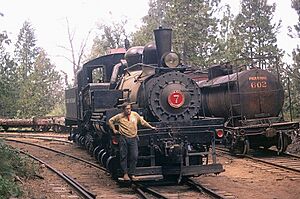Pacific Locomotive Association facts for kids
The Pacific Locomotive Association, Inc. (PLA) is a non-profit group that loves trains and wants to save the history of railroads on the Pacific Coast. They focus on the time from 1910 to 1960. The PLA runs the Niles Canyon Railway, where people can ride old trains. They also have a museum called the Niles Depot Museum in Fremont, California, which displays many old train items. The PLA owns a large collection of locomotives and other railroad cars, and they are always working to fix them up.
Contents
How the PLA Started and Grew
Early Days: Saving History
The PLA was started in 1961 by six people from the San Francisco area. They wanted to save old steam trains, which were disappearing from the main railroads. The group aimed to run special train trips to interesting places and keep parts of the steam train era safe for the future.
One of their first trips in May 1961 was to see the Howard Terminal Railway's last steam locomotive, No. 6. After this trip, the engine was retired. Three members of the PLA bought this engine for $250, promising it would never be scrapped. This made No. 6 the very first piece of railroad history saved by the PLA.
A month later, they visited the Blake Brothers rail operation near San Francisco Bay. They even had to dig out the rails, which were covered in years of dust, to run an old Heisler locomotive.
Official Start and First Trips
The Pacific Locomotive Association officially formed in July 1961 in Burlingame, California. The first members were Charles Heimerdinger, Jr., Karl R. Koenig, Henry Luna, Thomas Eikrenkotter, Bart Gregg, and Robert Field. Henry Luna was chosen as the first president. Because there were six founding members and their first saved engine was No. 6, the PLA's logo looks like a train's number plate with a "6" in the middle.
In 1962, the PLA offered two public trips on the California Western Railroad. The first trip, from Fort Bragg to Willits, sold out quickly. So, they did it again a month later. A round-trip ticket, including coffee and donuts, cost $6.35. The historic M200 "Skunk" train, built in 1926, was later bought by the PLA to save it from being scrapped. It now runs regularly on the Niles Canyon Railway.
Joining Forces and Sharing News
In the mid-1990s, a group called "Project 2467 Inc." joined the PLA. This group was made up of current and former Southern Pacific employees who wanted to restore and keep Southern Pacific steam locomotive number 2467.
The PLA also started a monthly news bulletin for its members. This bulletin grew into a full railroad news magazine called Pacific News. It was first made by Karl R. Koenig using a special printing machine. As more people wanted it, it was printed professionally. The magazine eventually became its own company and was later renamed Pacific RailNews and then Rail News. It was very popular for many years but stopped being published in 1999.
More Trains and a New Home
In 1965, the PLA received two more steam locomotives as a gift: No. 5, a rare three-truck Heisler, and No. 12, the oldest known standard gauge three-truck Shay locomotive.
By 1967, the Blake Brothers quarry railroad, which the PLA had used, stopped its train operations. This railroad, once known as the Castro Point Railway, was leased to the PLA for just one dollar a year. As the PLA got more historic trains and cars, they moved them to the Castro Point Railway. In 1973, they made a deal to use tracks at the nearby Point Molate Naval Fuel Depot to store and fix their equipment.
Over the years, the PLA collected eleven steam locomotives, ten internal combustion locomotives, and more than 35 passenger and freight cars. Many of these were fixed up and used on the Castro Point Railway. This train museum was open to the public from 1969 until December 1985. The U.S. Navy then ended the agreement because of security concerns.
As operations at Castro Point were ending, the Southern Pacific Railroad was stopping service on its line through Niles Canyon. The county agreed to lease the Niles Canyon part of the tracks to the PLA. This became the new home for the PLA's collection and operations.
Volunteer PLA members began to rebuild the tracks using rails donated by both the Southern Pacific and Union Pacific Railroad. The first part of the track, between Sunol and Brightside, opened on May 21, 1988. The California Western "Skunk" M200 was the first train to run on it. By 1998, the tracks reached downtown Niles. Today, the PLA runs the Niles Canyon Railway, a seven-mile railroad through the beautiful Niles Canyon. Thousands of people visit it every year. The PLA is still working to rebuild the tracks further east, between Sunol and Pleasanton.
What the PLA Does Today
Joining the PLA Community
Today, the PLA has over 1000 members and supporters. There are many ways for members to get involved. Some enjoy special train trips to unique places. Others like the social events, such as monthly meetings, barbecues, and dinners. Many members are interested in saving railroad history through research, writing, photography, or working on the Niles Canyon Railway. People who don't live near the Bay Area can still help by donating to support the museum's growth and improvements.
Exploring the World by Rail
The PLA continues to offer public train trips on many of California's railroads, including the Sierra, Santa Fe, McCloud, and Union Pacific lines. Some trips have even taken members to other countries like Canada, Ecuador, Chile, Cuba, and China.
Volunteering at Niles Canyon
At Niles Canyon, all the work to restore trains, expand the railway, and maintain tracks, locomotives, cars, and buildings is done by PLA volunteer members. There are jobs for everyone, from simple tasks that need no experience to skilled roles like mechanical technician, locomotive engineer, or other train crew members.


